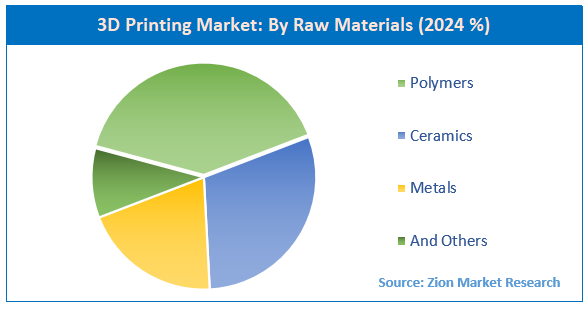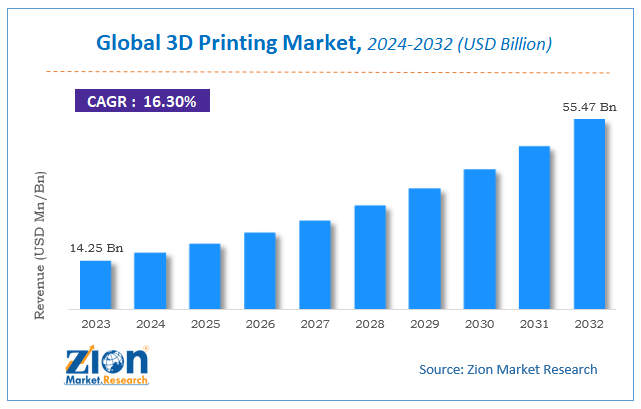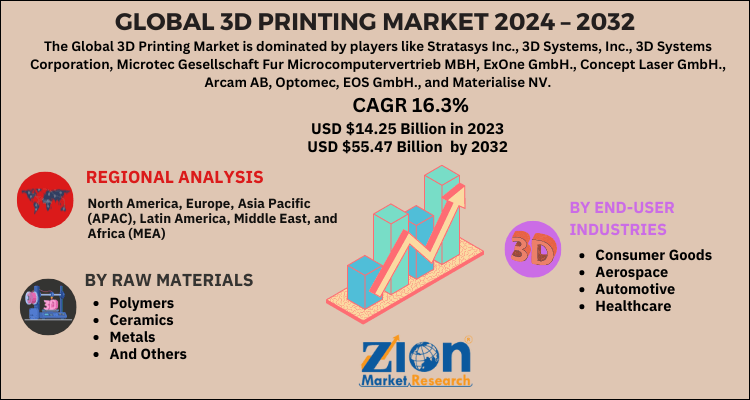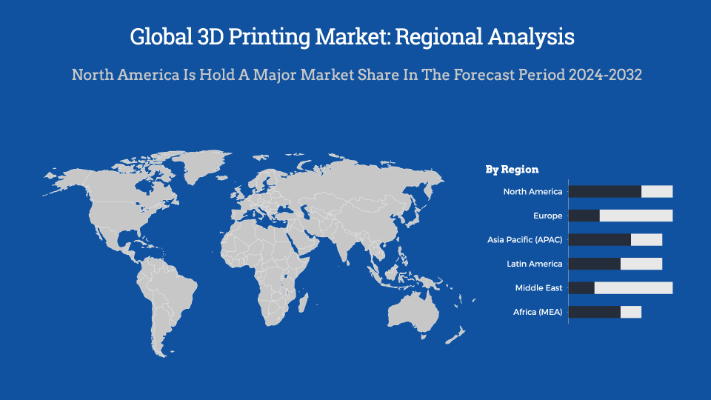3D Printing Market Size, Share, Trends, Growth and Forecast 2032

3D Printing Market By raw materials (polymers, ceramics, metals, and others), By end-user industries (consumer goods, aerospace, automotive, and healthcare) And By Region: - Global And Regional Industry Overview, Market Intelligence, Comprehensive Analysis, Historical Data, And Forecasts, 2024-2032
| Market Size in 2023 | Market Forecast in 2032 | CAGR (in %) | Base Year |
|---|---|---|---|
| USD 14.25 Billion | USD 55.47 Billion | 16.3% | 2023 |
Description
Global 3D Printing Market: Insights
According to the report published by Zion Market Research, the global 3D Printing Market size was valued at USD 14.25 Billion in 2023 and is predicted to reach USD 55.47 Billion by the end of 2032. The market is expected to grow with a CAGR of 16.3% during the forecast period. The report analyzes the global 3D Printing Market's growth drivers, restraints, and impact on demand during the forecast period. It will also help navigate and explore the arising opportunities in the 3D Printing industry.
Key Insights:
- As per the analysis shared by our research analyst, the 3D printing market is anticipated to grow at a CAGR of 16.3% during the forecast period.
- The global 3D printing market was estimated to be worth approximately USD 14.25 billion in 2023 and is projected to reach a value of USD 55.47 billion by 2032.
- The growth of the 3D printing market is being driven by increasing adoption across industries such as healthcare, aerospace, automotive, consumer goods, and construction.
- Based on the raw materials, the polymers segment is growing at a high rate and is projected to dominate the market.
- On the basis of end-user industries, the consumer goods segment is projected to swipe the largest market share.
- By region, North America is expected to dominate the global market during the forecast period.
Global 3D Printing Market: Overview
3D printing helps in the creation of the three dimensional solid objects which are made with the help of the digital files, it is also known as additive manufacturing. For the generation of the 3D objects, additive process is used. The process involves the building of the products through layering, thus avoiding the intervention of cutting, drilling, etc. With the help of this technology, the production of spare parts has become very easy.
Global 3D Printing Market: Growth Factors
In the coming years, the global 3D printing market will grow significantly. Factors that are contributing to the market growth are rise in the regulatory support from the government, increase in the end-user segments, rise in the investments and funding by the manufacturers for the research and development activities in the field of product development, and the ease in the manufacturing activities. High material cost, unavailability and poor quality of materials are expected to be a restraining factor for market growth.
The manufacturers are inclining towards the development of the products that are of low volume and cost that can be used widely across different industries. The technological advancements that are made in the healthcare sector increases the application of the 3D printing, thus opening up opportunities for the market growth. There are certain factors that are limiting the growth of the market such as absence of the experts that can use and manage this technology, lack of the availability of this technology, and lack of training facilities.
Recent Developmentst
- In July 2025, researchers at MIT unveiled the world’s first chip-based 3D printer, integrating a novel design directly onto a single computer chip. The chip uses beams of light to cure resin and fabricate micro-scale designs. Future iterations aim to evolve this technology into a fully volumetric 3D printer on a chip.
- In May 2023, Stratasys and Desktop Metal announced a merger valued at approximately US$1.8 billion, structured as an all-stock deal. The combined entity targets annual revenues of around US$1.1 billion by 2025, leveraging Stratasys’s expertise in polymer-based printing and Desktop Metal’s capabilities in metal and industrial-scale applications.
- In 2022, Nano Dimension acquired Global Inkjet Systems (GIS), a company specializing in printhead control electronics and ink delivery systems. The acquisition bolstered Nano Dimension’s inkjet printing and electronics materials stack.
- In 2022, Markforged expanded its portfolio through two strategic acquisitions. It first acquired Teton Simulation, known for its high-performance plastics and carbon fiber composite printing software. Later, it acquired Digital Metal, a specialist in binder jet metal printing, enhancing its capabilities in advanced materials and metal additive manufacturing.
- In 2021, 3D Systems acquired Oqton for approximately US$180 million. The acquisition brought advanced software capabilities including AI, automation, robotics, and machine learning into 3D Systems’ hardware and services ecosystem, enabling deeper integration and smarter workflows.
Global 3D Printing Market: Report Scope
| Report Attributes | Report Details |
|---|---|
| Report Name | 3D Printing Market |
| Market Size in 2023 | USD 14.25 Billion |
| Market Forecast in 2032 | USD 55.47 Billion |
| Growth Rate | CAGR of 16.3% |
| Number of Pages | 218 |
| Key Companies Covered | Stratasys Inc., 3D Systems, Inc., 3D Systems Corporation, Microtec Gesellschaft Fur Microcomputervertrieb MBH, ExOne GmbH., Concept Laser GmbH., Arcam AB, Optomec, EOS GmbH., and Materialise NV |
| Segments Covered | By Raw Materials, By End-User Industries and By Region |
| Regions Covered | North America, Europe, Asia Pacific (APAC), Latin America, Middle East, and Africa (MEA) |
| Base Year | 2023 |
| Historical Year | 2018 to 2022 |
| Forecast Year | 2024 - 2032 |
| Customization Scope | Avail customized purchase options to meet your exact research needs. Request For Customization |
Global 3D Printing Market: Segmentation
The market for the 3D printing is globally fragmented into raw materials and end-user industries. All the segments have been analyzed based on present and future trends and the market is estimated from 2024 to 2032.
On the basis of Raw Material, the global market is segregated into polymers, ceramics, metals, and others.
Based on the End-Use Industry, the market is categorized into consumer goods, aerospace, automotive, and healthcare.
The Regional segment includes the current and forecast demand for North America, Europe, Asia Pacific, Latin America, and the Middle East and Africa.
The aerospace and the automotive end-user industry is expected to dominate the 3D printing market.
3D Printing Market Dynamics
Key Growth Drivers
The 3D printing market is experiencing significant growth driven by the rising demand for customized products and rapid prototyping across various industries. 3D printing, also known as additive manufacturing, allows for the creation of intricate and complex geometries that are not possible with traditional manufacturing methods. This capability is particularly valuable in sectors like healthcare, where it is used to produce patient-specific implants and prosthetics, and in the automotive and aerospace industries for lightweight and high-performance components. Additionally, ongoing advancements in materials science, with the development of new metal alloys, composites, and biocompatible filaments, are broadening the applications of 3D printing from simple prototyping to end-use functional parts, thereby fueling its adoption.
Restraints
Despite its advantages, the 3D printing market faces several significant restraints. One of the primary barriers to widespread adoption is the high initial investment required for industrial-grade printers and the high cost of specialized materials. This makes it difficult for small and medium-sized enterprises (SMEs) to integrate the technology into their operations. The market is also hindered by the lack of a standardized process control, as quality and consistency can vary depending on the machine, material, and operator. This makes it challenging to ensure that 3D-printed parts meet the rigorous quality and safety standards required in industries like aerospace and medical devices. Furthermore, the limited build size of most printers and the slower production speeds compared to mass manufacturing methods like injection molding are significant restraints for high-volume production.
Opportunities
The 3D printing market is ripe with opportunities for innovation and expansion. The integration of Artificial Intelligence (AI) and Machine Learning (ML) is a key opportunity, as these technologies can optimize part design for additive manufacturing, predict material performance, and automate the entire workflow, from design to post-processing. The shift toward decentralized and on-demand manufacturing is another major opportunity, as 3D printing enables the creation of localized micro-factories that can produce goods closer to the point of consumption, thereby shortening supply chains and reducing inventory costs. The growing demand for sustainable and eco-friendly manufacturing processes also presents an opportunity, as 3D printing can reduce material waste by building parts layer-by-layer and allows for the use of recycled and biodegradable materials.
Challenges
The 3D printing market faces a number of complex challenges. A major technical challenge is the post-processing required for many 3D-printed parts to achieve the desired surface finish, which can be a time-consuming and labor-intensive process. The lack of a skilled workforce with the expertise in design, operation, and maintenance of 3D printing systems is also a significant hurdle for businesses. Additionally, the industry must contend with intellectual property (IP) and copyright issues, as the ease of replicating and distributing digital designs for 3D printing makes it difficult to protect original creations. Lastly, the absence of a universal regulatory framework and clear standards for materials and processes can create uncertainty and compliance challenges for manufacturers operating on a global scale.
Global 3D Printing Market: Regional Analysis
Based on the regions, the market for 3D printing is diversified into the Middle East & Africa, Eastern Europe, Western Europe, North America, Latin America, and Asia Pacific. The largest market share in the 3D printing market is held by North America. The key factor that contributes to the market growth in the North America is the wide development that is made in the 3D technology. Another factor that contributes to the market growth is the large amount of dental labs found in this region. North America is followed by Europe and Asia-Pacific regions. It is expected that these markets will grow rapidly in the coming years. In the Asia Pacific region, the emerging country Japan has the largest market for 3D printing owing to the factors such as the supportive government policies, increasing investments made by the government for the development of the printing technology, and the high sale of the professional-grade printers. China follows Japan in the Asia Pacific region.
Global 3D Printing Market: Competitive Players
The key market players that are involved in the 3D printing market include:
- Stratasys Inc.
- 3D Systems, Inc.
- 3D Systems Corporation
- Microtec Gesellschaft Fur Microcomputervertrieb MBH
- ExOne GmbH.
- Concept Laser GmbH.
- Arcam AB
- Optomec
- EOS GmbH.
- Materialise NV
 Request Free Sample
Request Free Sample
Global 3D Printing Market: Segmentation
The Global 3D Printing Market is segmented as follows:
By Raw Materials
- Polymers
- Ceramics
- Metals
- And Others
By End-User Industries
- Consumer Goods
- Aerospace
- Automotive
- Healthcare
Global 3D Printing Market: Regional Segment Analysis
- North America
- U.S.
- Europe
- UK
- France
- Germany
- Asia Pacific
- China
- Japan
- India
- Latin America
- Brazil
- Middle East and Africa
What Reports Provides
- Full in-depth analysis of the parent market
- Important changes in market dynamics
- Segmentation details of the market
- Former, on-going, and projected market analysis in terms of volume and value
- Assessment of niche industry developments
- Market share analysis
- Key strategies of major players
- Emerging segments and regional markets
- Testimonials to companies in order to fortify their foothold in the market.
Table Of Content
FrequentlyAsked Questions
3D printing helps in the creation of the three dimensional solid objects which are made with the help of the digital files, it is also known as additive manufacturing. For the generation of the 3D objects, additive process is used. The process involves the building of the products through layering, thus avoiding the intervention of cutting, drilling, etc. With the help of this technology, the production of spare parts has become very easy.
The 3D Printing Market was valued at USD 14.25 Billion in 2023.
The 3D Printing Market is expected to reach USD 55.47 Billion by 2032, growing at a CAGR of of 16.3% between 2024 to 2032.
In the coming years, the global 3D printing market will grow significantly. Factors that are contributing to the market growth are rise in the regulatory support from the government, increase in the end-user segments, rise in the investments and funding by the manufacturers for the research and development activities in the field of product development, and the ease in the manufacturing activities. High material cost, unavailability and poor quality of materials are expected to be a restraining factor for market growth.
Global 3D Printing Market players such as Stratasys Inc., 3D Systems, Inc., 3D Systems Corporation, Microtec Gesellschaft Fur Microcomputervertrieb MBH, ExOne GmbH., Concept Laser GmbH., Arcam AB, Optomec, EOS GmbH., and Materialise NV.
The Regional segment includes the current and forecast demand for North America, Europe, Asia Pacific, Latin America, and the Middle East and Africa.
HappyClients
Zion Market Research
Tel: +1 (302) 444-0166
USA/Canada Toll Free No.+1 (855) 465-4651
3rd Floor,
Mrunal Paradise, Opp Maharaja Hotel,
Pimple Gurav, Pune 411061,
Maharashtra, India
Phone No +91 7768 006 007, +91 7768 006 008
US OFFICE NO +1 (302) 444-0166
US/CAN TOLL FREE +1 (855) 465-4651
Email: sales@zionmarketresearch.com
We have secured system to process your transaction.
Our support available to help you 24 hours a day, five days a week.
Monday - Friday: 9AM - 6PM
Saturday - Sunday: Closed







